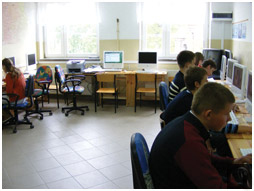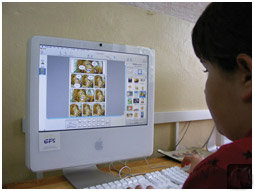The Benefits of Comic Life in Education
Making comics is fun for everyone, and Comic Life makes it easy. Teachers and students will find Comic Life a very useful software tool, and now it’s available for both Mac and Windows platforms.
Technology not only changes how we write, but it also changes what writing is. Education will need to re-evaluate which writing skills teachers should pass to their students. Digital graphic writing is one genre students need to be fluent. Comic Life is the “word processor” of digital graphic writing.
Easy to Learn
Students and teachers need only a short time to learn the basics of Comic Life. It’s easy to add images from digital cameras, computer web-cameras, clip art from CD’s and the web, stills from QuickTime movies, scanned photos and drawings – just about any on-screen image can be used in Comic Life. Adding captions and word balloons is as easy as drag and drop.
and the web, stills from QuickTime movies, scanned photos and drawings – just about any on-screen image can be used in Comic Life. Adding captions and word balloons is as easy as drag and drop.
Inexpensive
Schools often don’t have money to buy expensive software. At $19.95 for a single license, however, any teacher will find Comic Life a bargain, and administrators will find the cost of licensing Comic Life for labs affordable.
Inspires Creativity
Teachers are often asked to identify talented and gifted students by their ability to make “unusual connections.” Talented and gifted students offer creative explanations for their answers which seem to come out of nowhere. Comic Life is the perfect software tool for all students to be creative. Comic Life will inspire everyone — teachers and students — to approach learning in new ways.
The Benefits of Comics in Education
Comics are beneficial to learning in the classroom and not just a fun art-enrichment activity.
Reading
Comics provide narrative experiences for students just beginning to read and for students acquiring a new language. Students follow story beginnings and endings, plot, characters, time and setting, sequencing without needing sophisticated word decoding skills. Images support the text and give students significant contextual clues to word meaning. Comics act as a scaffold to student understanding. As Stephen Cary, a second language learner specialist and author of Going Graphic: Comics at Work in the Multilingual Classroom, says: “Comics provide authentic language learning opportunities for all students…. The dramatically reduced text of many comics make them manageable and language profitable for even beginning level readers.”
students significant contextual clues to word meaning. Comics act as a scaffold to student understanding. As Stephen Cary, a second language learner specialist and author of Going Graphic: Comics at Work in the Multilingual Classroom, says: “Comics provide authentic language learning opportunities for all students…. The dramatically reduced text of many comics make them manageable and language profitable for even beginning level readers.”
Also according to Cary, comics motivate reluctant readers. They engage students in a literary format which is their own. Comics speak to students in a way they understand and identify with. Even after students learn to be strong readers comics give students the opportunity to read material which combines images with text to express satire, symbolism, point of view, drama, puns and humor in ways not possible with text alone.
Writing
Many students read fluently, but find it difficult to write. They complain that they don’t know what to write. They have ideas, but they lack the written language skills to create a beginning, follow a sequence of ideas and then draw their writing to a logical conclusion.
Students frequently ask if they may draw a picture when they’re writing. They are reaching for images to support their language ideas. Allowed to use words and images they will resolve problems of storytelling which they would not otherwise experience using words alone. Like reading, comics provide a scaffolding so that students experience success in their writing. Students transfer specific elements directly into text-only writing. For example, students learn that whatever text found in a word balloon is put inside quotes in their text-only writing.
Using Comic Life students have a new publishing medium. Comic Life documents can be printed, emailed to parents or posted as a website very easily.
Key benefits of using comics in education
– A great visual Representation of Knowledge
– Presents what is essential
– Easier to remember a visual graphic containing key information
– Engaging through thinking, creating and writing.
– Perfect avenue for writing dialogue
– Incites students with low interest in writing
– Helps organization through storytelling and storyboarding
– Using visual images convey meaning to a story or topic
– Develops creative and higher level thought processes
– Develops composition techniques through visual-verbal connections
– Enriches reading, writing, and thinking
– Serves as and assessment and evaluation tool
– Sequencing promotes understanding
The key benefits for students using Comics, summarised by Marilee Sarlitto (Technology Director, Kildeer School), found in “Creating Comics: Visual and Verbal Thinking in the Ultimate Show and Tell” by Janette Combs, College of William and Mary, July 17, 2003.
This article was published at: www.comiclife.com
